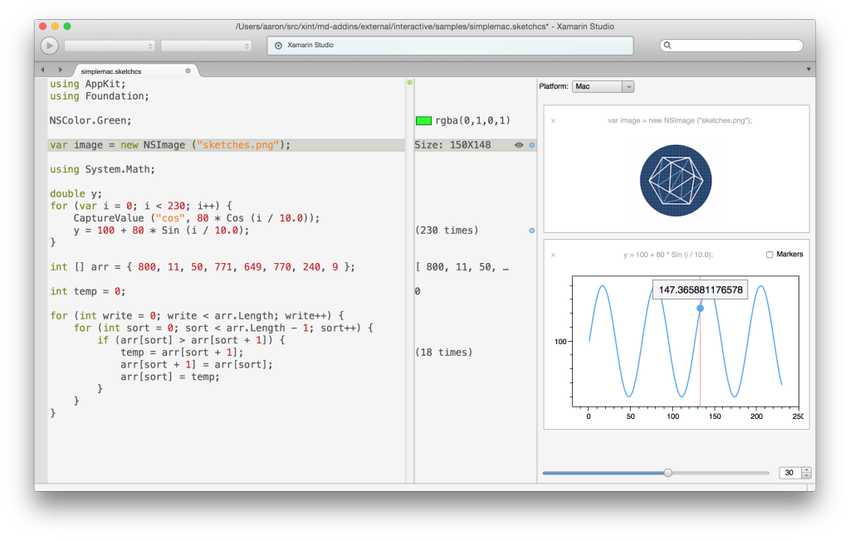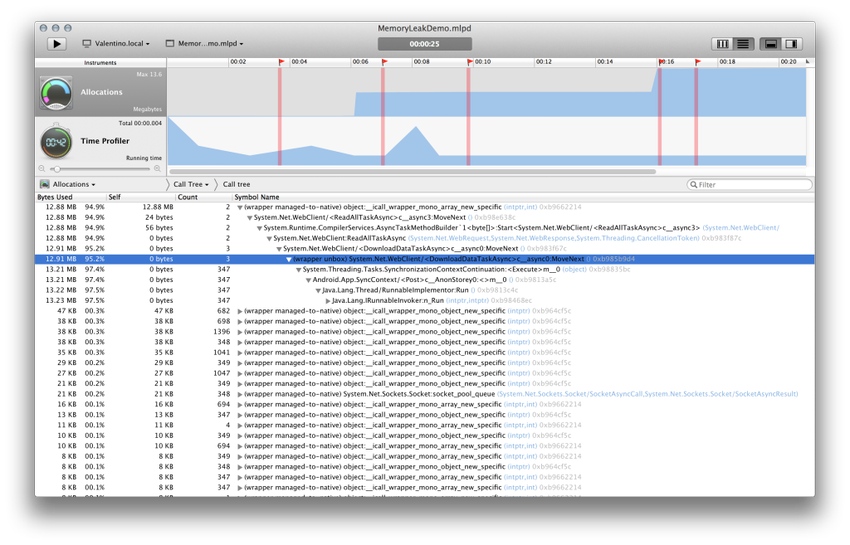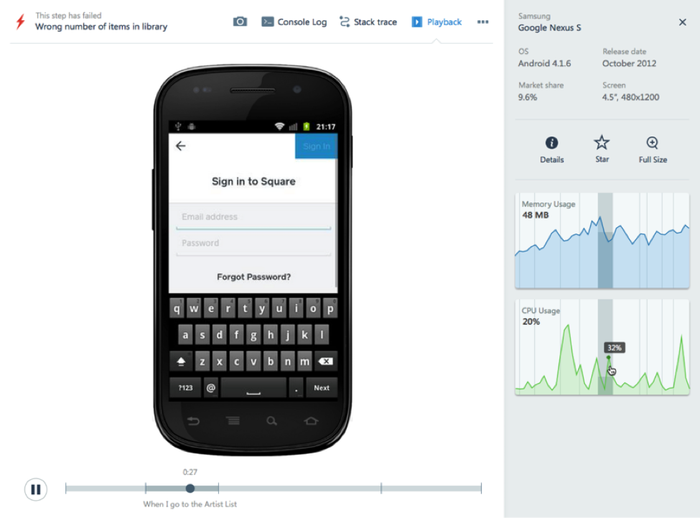News from Xamarin Evolve 2014 - Insights monitoring system, Android Player emulator, Profiler, UITest, prototyping in Sketches
- Xamarin Insights - a new monitoring system keeps track of everything that happens in the application, from uncaught exceptions to button clicks, including the duration of operations and device data
- Xamarin Android Player emulator runs on Windows or Mac using hardware virtualization and allows you to quickly debug applications
- Sketches allow you to quickly outline a code in C # or F # and immediately see the results of its execution including the user interface
')
- Xamarin Profiler collects information on performance issues and memory leaks
- Xamarin Test Cloud improvements include Xamarin.UITest - a new framework for automatic, cross-platform testing of the user interface in the Xamarin Test Cloud, video recording of what is happening on the device screen during the test and hyper-parallel testing on a large number of devices, reducing the time required for testing
- the six largest component developers for .Net - Syncfusion , Telerik , Infragistics , Steema , ComponentOne , DevExpress , transferred them to Xamarin.Forms. All components will be available at the Xamarin Component store this year. SyncFusion and Telerik components are available right now. A partnership agreement has been concluded with IBM, as expressed in the IBM MobileFirst SDK for Xamarin and IBM MobileFirst Add-Ons for Xamarin Studio and Visual Studio.

Xamarin Insights is a real-time monitoring system that allows you to identify and monitor situations affecting users using a simple and effective API. You can add Insights to applications with a single line of code. Insights will report any untapped native or managed exceptions. In addition to this, you can track both completed and active sessions, along with full access to device statistics, such as the operating system and screen resolution.

If you want more control, you can track all caught exceptions along with any additional data that will help you understand what's happening, using a simple API Insights. In addition to tracking crashes, Insights allow you to track any events that occur in your application, causing a single method — from page views to button clicks. You can also monitor performance by recording the time it takes to perform slow operations. Insights allow you to combine event tracking with user identification so that you can examine any desired details and reproduce the situation in which an error occurred.
All information is available from the Insights admin panel. But since developers need real-time feedback, Insights easily integrates with services like GitHub, HipChat, Visual Studio Online, Campfire and many others, allowing you to instantly receive alerts about important information for you. For several months from now, Xamarin Insights will be available to all Xamarin subscribers for free. Prices will be announced at the end of this period, but a fairly generous plan will be included in the Xamarin subscription at no additional charge.
One of the most painful places for all Android developers is an outdated, slow and inconvenient emulator. The new Xamarin Android Player uses hardware virtualization (VT-x and AMD-V) and graphics acceleration (OpenGL 2.0) on Windows or Mac to ensure the fastest possible launch and best performance. Android Player is built using Xamarin.Mac on OSX, WPF on Windows and uses native interfaces optimized for the idioms of each platform. The user interface shows battery status, GPS location and integrates directly into ADB, allowing all existing tools to work directly with the new emulator. Installing an APK and adding Google Play Services is very simple - just drag the APK into the Xamarin Android Player window. The preview version comes with Android KitKat 4.4.2, API Level 19, one form factor and is free for Xamarin subscribers. By the time of launch, Android images will be supplied for all major API levels and form factors, along with some new features.
Sketches improve the standard cycle "wrote, assembled, deployed, tested". Start writing code and see how it works. You will see the interim results of the changes you make along with the effect they have on the user interface. Sketches are well suited for learning new APIs, prototyping ideas, and fast iterations in design. Having found the code that suits you, you simply copy it into your application, or you can take part of the code from the application and study it in an isolated, but lively software environment. This is extremely useful when debugging. The preliminary version of Sketches is already available for iOS, Android, and Mac in the Xamarin Studio Beta Channel, and Visual Studio support for Android, iOS and Windows will be added soon. More in the documentation.

Reciprocal reminds work detective. It’s like investigating a crime or making a diagnosis — developers should use their skills to gather a solid picture, but a good tool like a magnifying glass or a stethoscope can help in gathering the evidence needed to solve a puzzle. Xamarin Profiler is a tool to help you open, analyze and improve your C # mobile application. The profiler collects information about the managed side of Xamarin apps for iOS and Android, helping you understand what it is worth spending time on improving the app. You can use it to look for memory leaks, performance bottlenecks, or just to lick an application before release. Xamarin Profiler is available in two versions — for Mac and Windows — that seamlessly integrate with your Xamarin toolkit. A preliminary version is already available for download.

Xamarin.UITest is a new framework for automated testing of the user interface in any mobile applications. Local tests with Xamarin.UITest run on your simulator or device and can output test results directly to Xamarin Studio or Visual Studio. Xamarin.UITest is based on Calabash, one of the world's most popular frameworks for automated testing of mobile applications. The framework provides a uniform interface for cross-platform testing of any applications for iOS or Android, including non-Xamarin applications and even hybrid applications that use HTML and CSS in WebViews. The local version has a lot of features, but the real power of Xamarin.UITest is that you can do a local test and place it on the Xamarin Test Cloud without any changes, having scaled your testing on more than 1000 true, unlocked Android and iOS devices to cloudy environments designed for performance and reliability. Xamarin.UITest can be installed from NuGet right now and start writing local tests using the documentation.

Improved Recording Tools
Xamarin Test Cloud generates screenshots as you progress through the steps of your test. This way you can make sure that your application looks great even at unusual permissions for you. However, some user experiences are poorly conveyed by some screenshots. To correct this, a preliminary version of the video of what is happening on the screen in the Xamarin Test Cloud is presented. It includes the complete passage of tests, including animation. The preliminary version is available for Android from version 4.0 and is fully integrated with the Xamarin Test Cloud web portal.

Improved test performance
An important improvement in the Xamarin Test Cloud is the hyper-parallel execution of tests. At the moment, when you run a test on 10 unique devices, this test is already simultaneously running on each of them, but the individual stages of the test are performed in turn. Hyper-parallel execution of tests takes this to a new level. In our laboratory, there are many instances of the same device, so that we can break up a set of tests into pieces and run them in parallel on the same devices. At the end, the results come together as if the test was performed on a single device, but you get the result much faster. We use Xamarin Test Cloud to test our own products. For example, the Xamarin.Forms team has one of the largest test suites, which takes 2.5 hours to complete in a standard configuration. With the introduction of hyper-parallelism, this time was reduced to 12 minutes.
Compiled from five entries on the Xamarin blog:
Enterprise Component Vendors Join Xamarin.Forms Ecosystem
Xamarin Platform Previews
New Xamarin Test Cloud Features
Introducing Xamarin Insights: Real-time Monitoring for Your Apps
IBM and Xamarin Partner to Accelerate Enterprise Mobility
- Xamarin Android Player emulator runs on Windows or Mac using hardware virtualization and allows you to quickly debug applications
- Sketches allow you to quickly outline a code in C # or F # and immediately see the results of its execution including the user interface
')
- Xamarin Profiler collects information on performance issues and memory leaks
- Xamarin Test Cloud improvements include Xamarin.UITest - a new framework for automatic, cross-platform testing of the user interface in the Xamarin Test Cloud, video recording of what is happening on the device screen during the test and hyper-parallel testing on a large number of devices, reducing the time required for testing
- the six largest component developers for .Net - Syncfusion , Telerik , Infragistics , Steema , ComponentOne , DevExpress , transferred them to Xamarin.Forms. All components will be available at the Xamarin Component store this year. SyncFusion and Telerik components are available right now. A partnership agreement has been concluded with IBM, as expressed in the IBM MobileFirst SDK for Xamarin and IBM MobileFirst Add-Ons for Xamarin Studio and Visual Studio.

Xamarin insights
Xamarin Insights is a real-time monitoring system that allows you to identify and monitor situations affecting users using a simple and effective API. You can add Insights to applications with a single line of code. Insights will report any untapped native or managed exceptions. In addition to this, you can track both completed and active sessions, along with full access to device statistics, such as the operating system and screen resolution.

If you want more control, you can track all caught exceptions along with any additional data that will help you understand what's happening, using a simple API Insights. In addition to tracking crashes, Insights allow you to track any events that occur in your application, causing a single method — from page views to button clicks. You can also monitor performance by recording the time it takes to perform slow operations. Insights allow you to combine event tracking with user identification so that you can examine any desired details and reproduce the situation in which an error occurred.
All information is available from the Insights admin panel. But since developers need real-time feedback, Insights easily integrates with services like GitHub, HipChat, Visual Studio Online, Campfire and many others, allowing you to instantly receive alerts about important information for you. For several months from now, Xamarin Insights will be available to all Xamarin subscribers for free. Prices will be announced at the end of this period, but a fairly generous plan will be included in the Xamarin subscription at no additional charge.
Xamarin Android Player
One of the most painful places for all Android developers is an outdated, slow and inconvenient emulator. The new Xamarin Android Player uses hardware virtualization (VT-x and AMD-V) and graphics acceleration (OpenGL 2.0) on Windows or Mac to ensure the fastest possible launch and best performance. Android Player is built using Xamarin.Mac on OSX, WPF on Windows and uses native interfaces optimized for the idioms of each platform. The user interface shows battery status, GPS location and integrates directly into ADB, allowing all existing tools to work directly with the new emulator. Installing an APK and adding Google Play Services is very simple - just drag the APK into the Xamarin Android Player window. The preview version comes with Android KitKat 4.4.2, API Level 19, one form factor and is free for Xamarin subscribers. By the time of launch, Android images will be supplied for all major API levels and form factors, along with some new features.
Sketches
Sketches improve the standard cycle "wrote, assembled, deployed, tested". Start writing code and see how it works. You will see the interim results of the changes you make along with the effect they have on the user interface. Sketches are well suited for learning new APIs, prototyping ideas, and fast iterations in design. Having found the code that suits you, you simply copy it into your application, or you can take part of the code from the application and study it in an isolated, but lively software environment. This is extremely useful when debugging. The preliminary version of Sketches is already available for iOS, Android, and Mac in the Xamarin Studio Beta Channel, and Visual Studio support for Android, iOS and Windows will be added soon. More in the documentation.

Profiler
Reciprocal reminds work detective. It’s like investigating a crime or making a diagnosis — developers should use their skills to gather a solid picture, but a good tool like a magnifying glass or a stethoscope can help in gathering the evidence needed to solve a puzzle. Xamarin Profiler is a tool to help you open, analyze and improve your C # mobile application. The profiler collects information about the managed side of Xamarin apps for iOS and Android, helping you understand what it is worth spending time on improving the app. You can use it to look for memory leaks, performance bottlenecks, or just to lick an application before release. Xamarin Profiler is available in two versions — for Mac and Windows — that seamlessly integrate with your Xamarin toolkit. A preliminary version is already available for download.

Xamarin.UITest and Xamarin Test Cloud
Xamarin.UITest is a new framework for automated testing of the user interface in any mobile applications. Local tests with Xamarin.UITest run on your simulator or device and can output test results directly to Xamarin Studio or Visual Studio. Xamarin.UITest is based on Calabash, one of the world's most popular frameworks for automated testing of mobile applications. The framework provides a uniform interface for cross-platform testing of any applications for iOS or Android, including non-Xamarin applications and even hybrid applications that use HTML and CSS in WebViews. The local version has a lot of features, but the real power of Xamarin.UITest is that you can do a local test and place it on the Xamarin Test Cloud without any changes, having scaled your testing on more than 1000 true, unlocked Android and iOS devices to cloudy environments designed for performance and reliability. Xamarin.UITest can be installed from NuGet right now and start writing local tests using the documentation.

Improved Recording Tools
Xamarin Test Cloud generates screenshots as you progress through the steps of your test. This way you can make sure that your application looks great even at unusual permissions for you. However, some user experiences are poorly conveyed by some screenshots. To correct this, a preliminary version of the video of what is happening on the screen in the Xamarin Test Cloud is presented. It includes the complete passage of tests, including animation. The preliminary version is available for Android from version 4.0 and is fully integrated with the Xamarin Test Cloud web portal.

Improved test performance
An important improvement in the Xamarin Test Cloud is the hyper-parallel execution of tests. At the moment, when you run a test on 10 unique devices, this test is already simultaneously running on each of them, but the individual stages of the test are performed in turn. Hyper-parallel execution of tests takes this to a new level. In our laboratory, there are many instances of the same device, so that we can break up a set of tests into pieces and run them in parallel on the same devices. At the end, the results come together as if the test was performed on a single device, but you get the result much faster. We use Xamarin Test Cloud to test our own products. For example, the Xamarin.Forms team has one of the largest test suites, which takes 2.5 hours to complete in a standard configuration. With the introduction of hyper-parallelism, this time was reduced to 12 minutes.
Compiled from five entries on the Xamarin blog:
Enterprise Component Vendors Join Xamarin.Forms Ecosystem
Xamarin Platform Previews
New Xamarin Test Cloud Features
Introducing Xamarin Insights: Real-time Monitoring for Your Apps
IBM and Xamarin Partner to Accelerate Enterprise Mobility
Source: https://habr.com/ru/post/240435/
All Articles